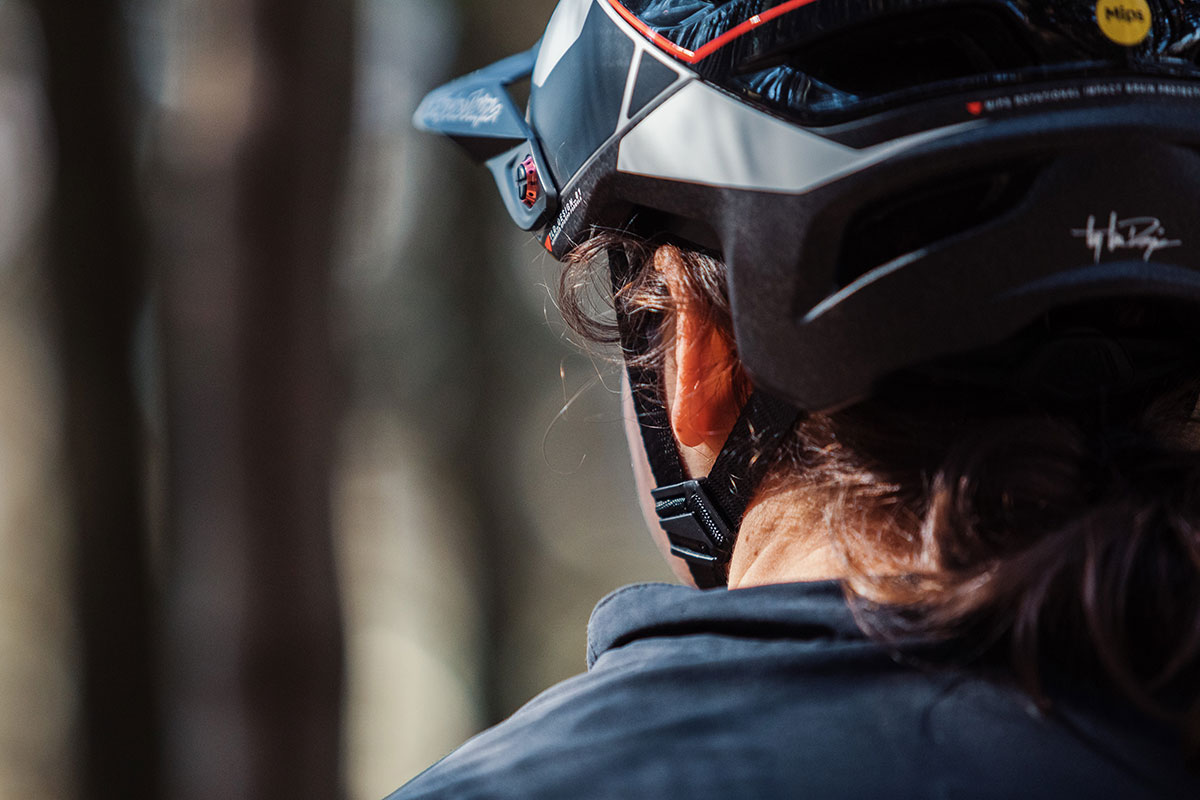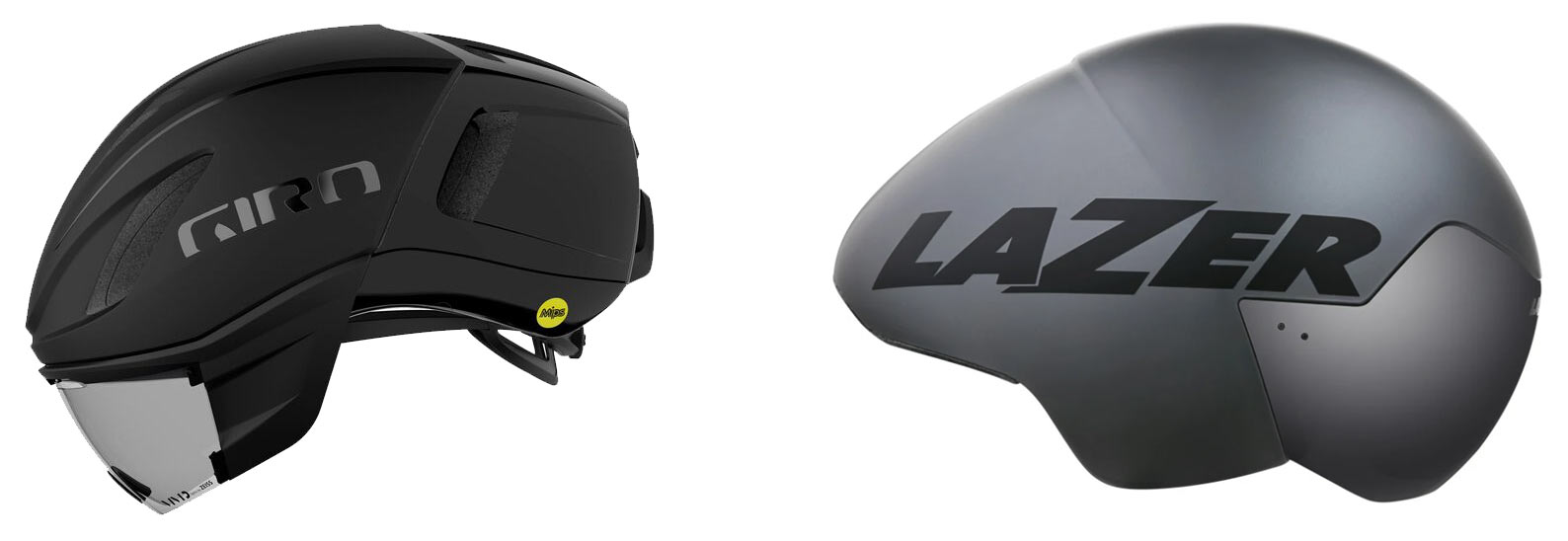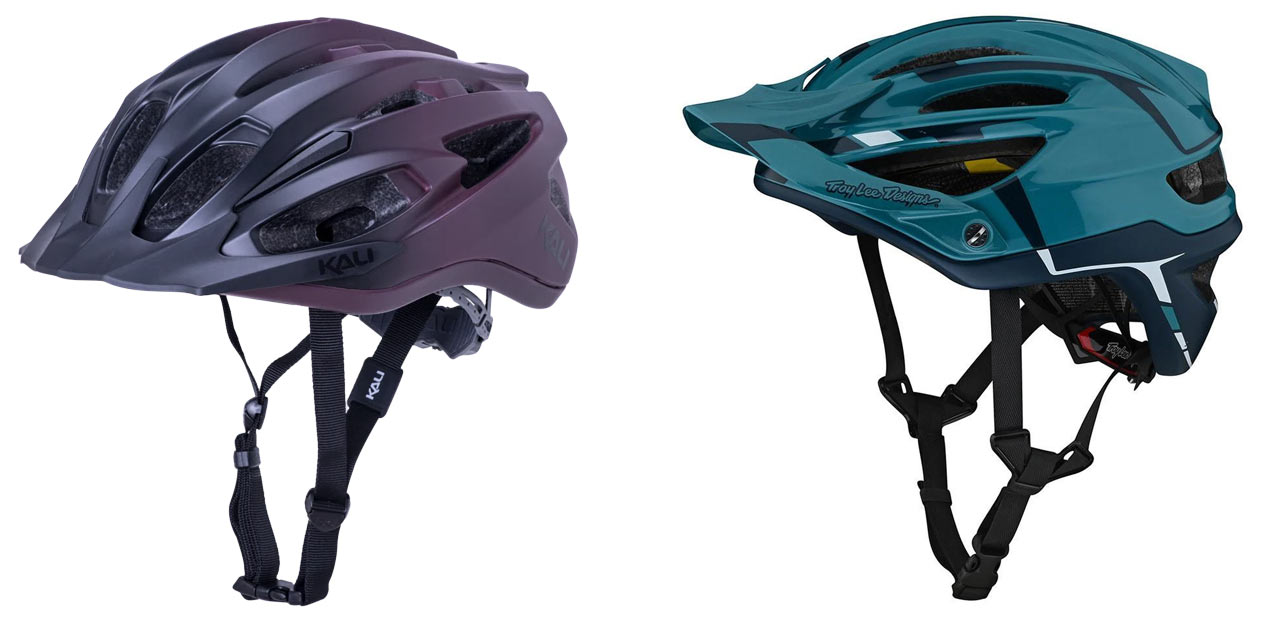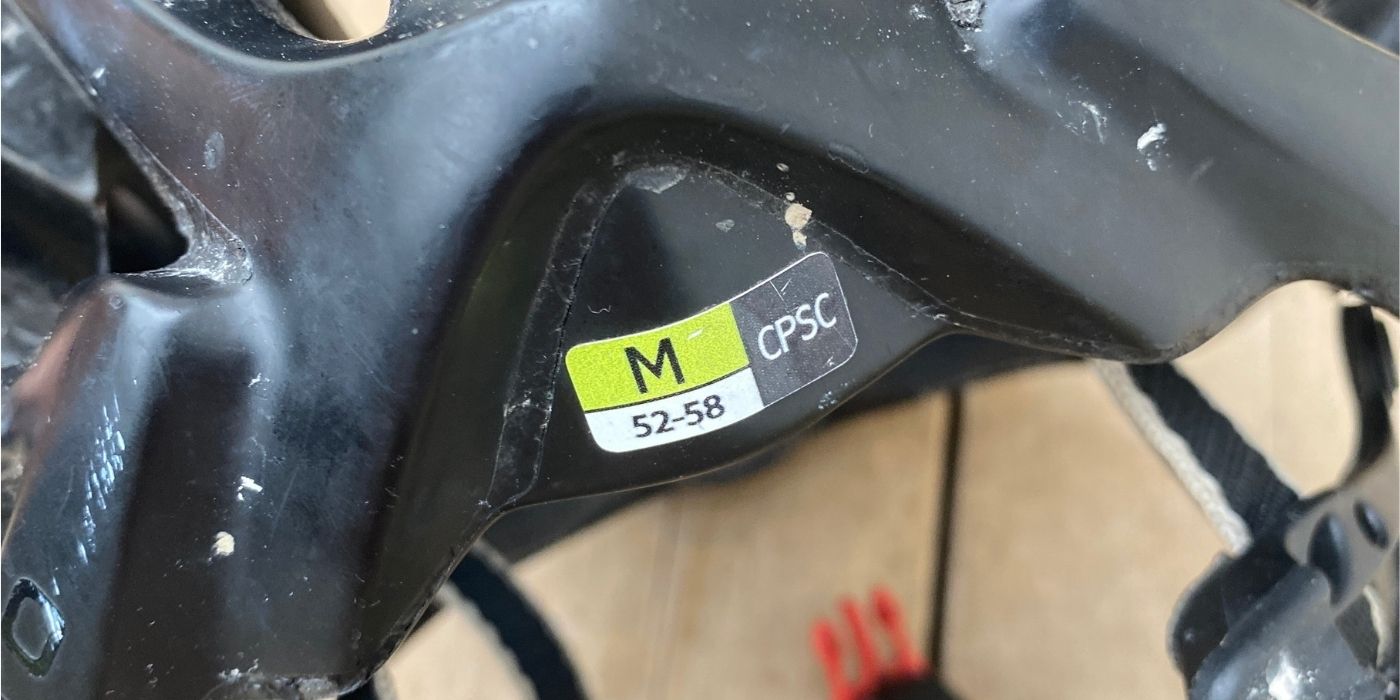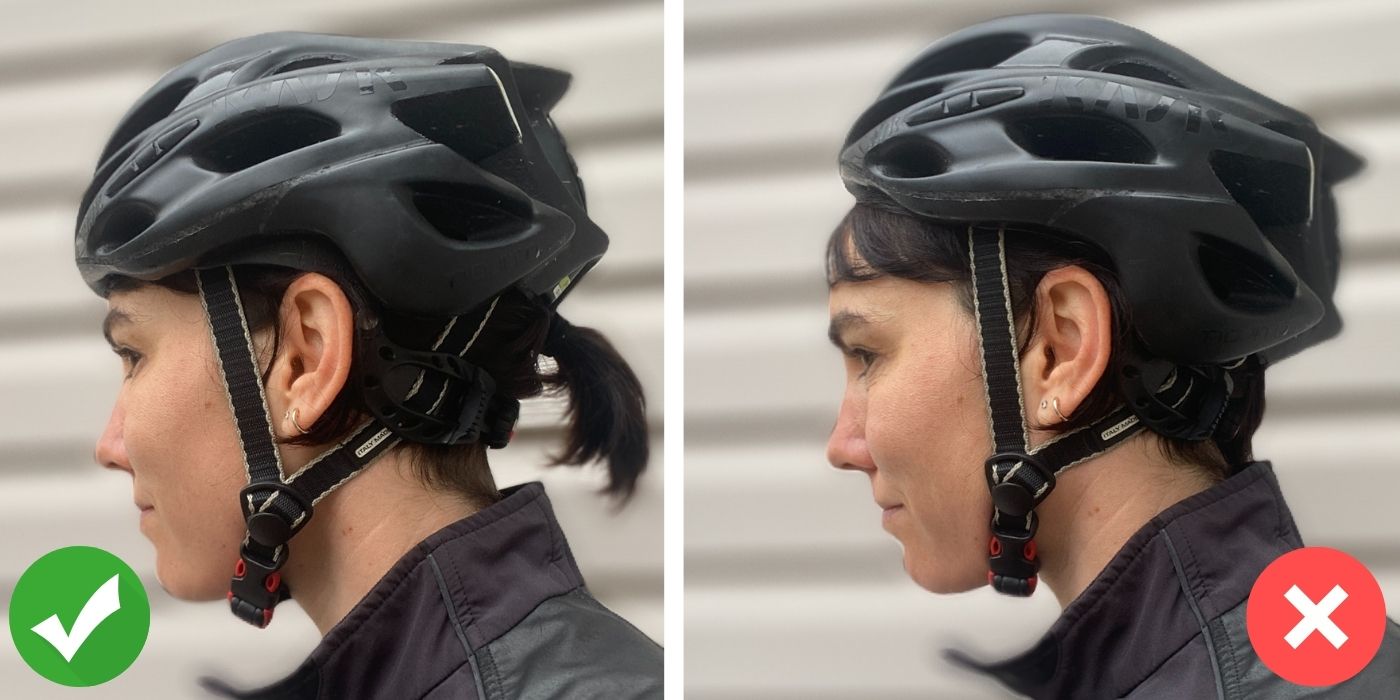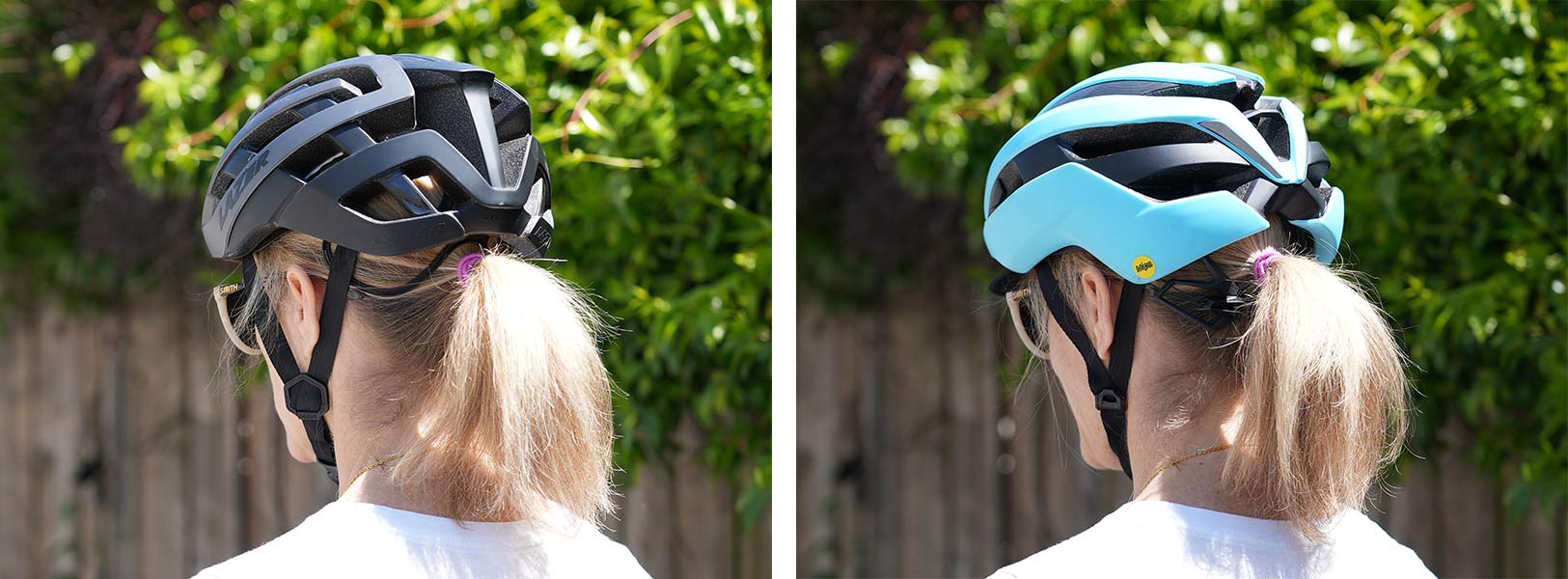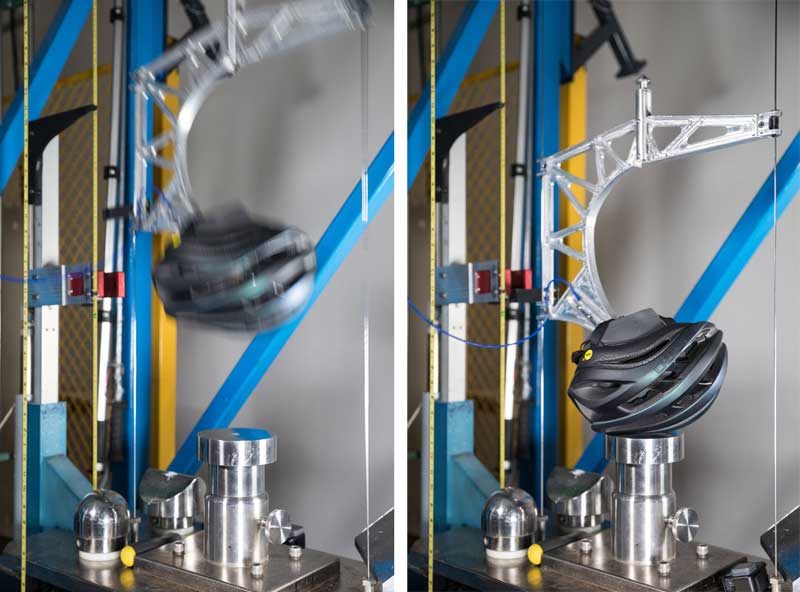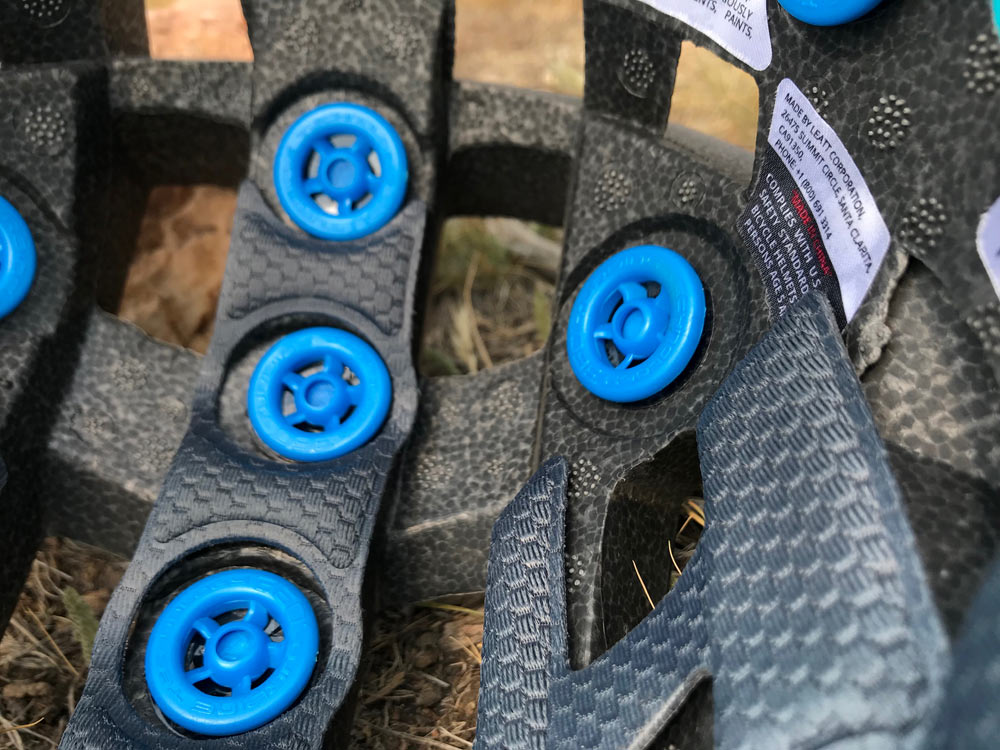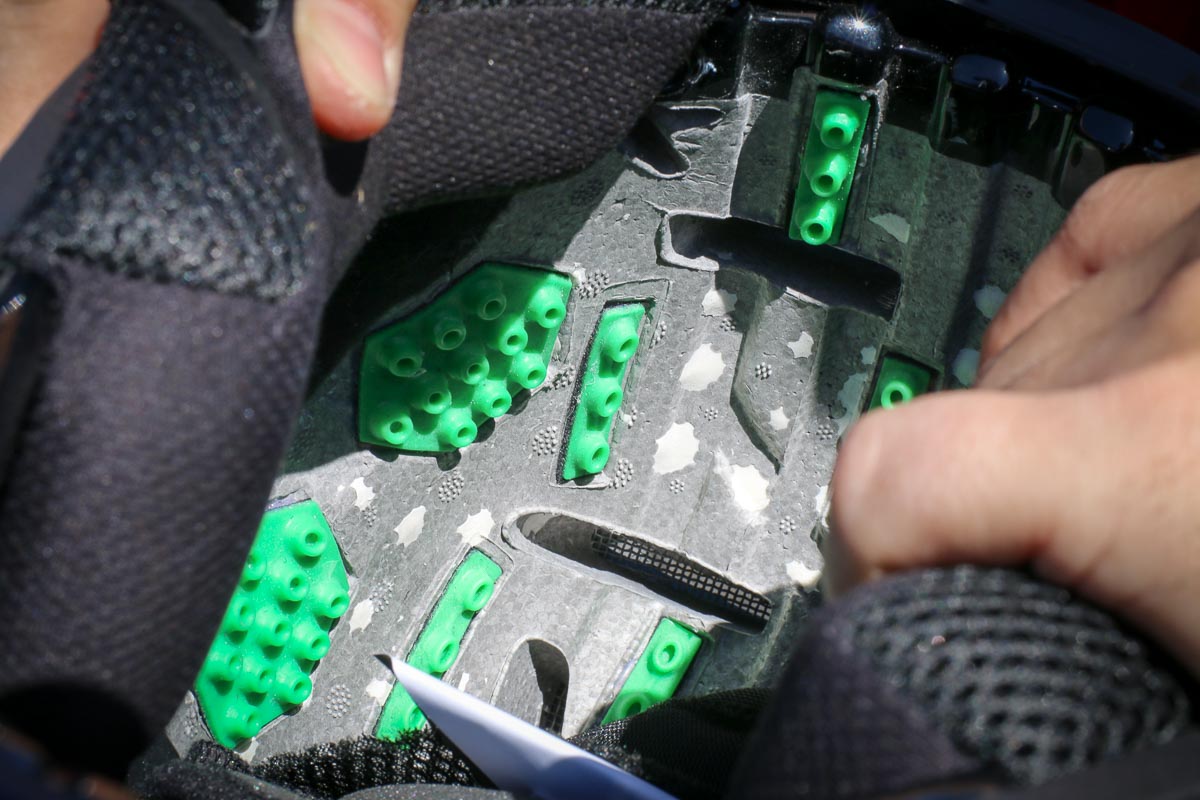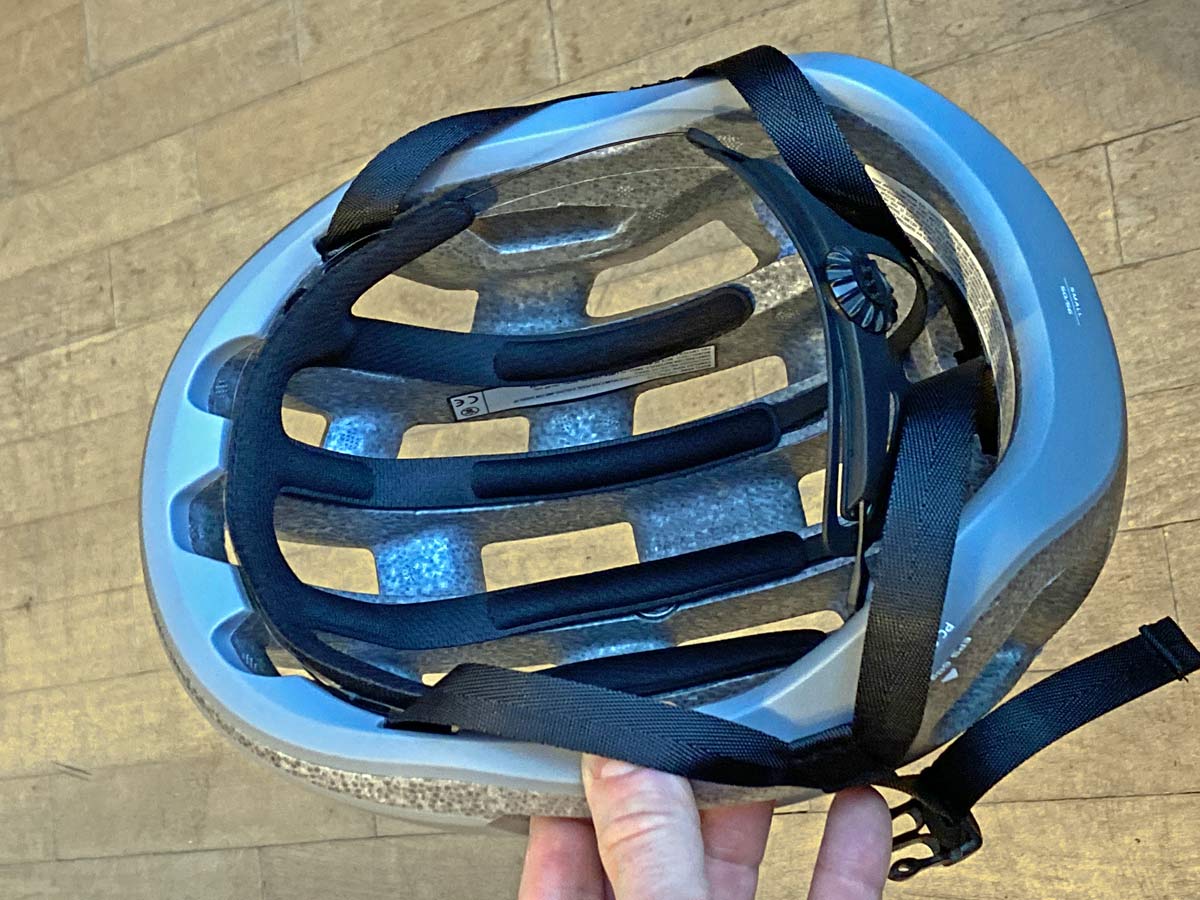At a glance, the bike helmet seems like one of the simplest pieces of bike gear on the market. That is until you go helmet shopping, and suddenly you’re confronted with not just a slew of different styles, shapes, and sizes, but also different safety features. What really matters in a helmet, and WTF does MIPS mean?
Here, we’re breaking down helmet features for you so that next time you’re helmet shopping, you know what to look for…
What’s the difference between road, gravel, commuter & mountain bike helmets?
How and where you’ll be using the helmet will guide you in determining which style of the helmet to choose. You don’t necessarily need a separate helmet for every type of riding that you do, but it’s important to know why they’re different so you can pick the best one for whatever combination of bikes and surfaces you ride. Any helmet is better than no helmet, though!
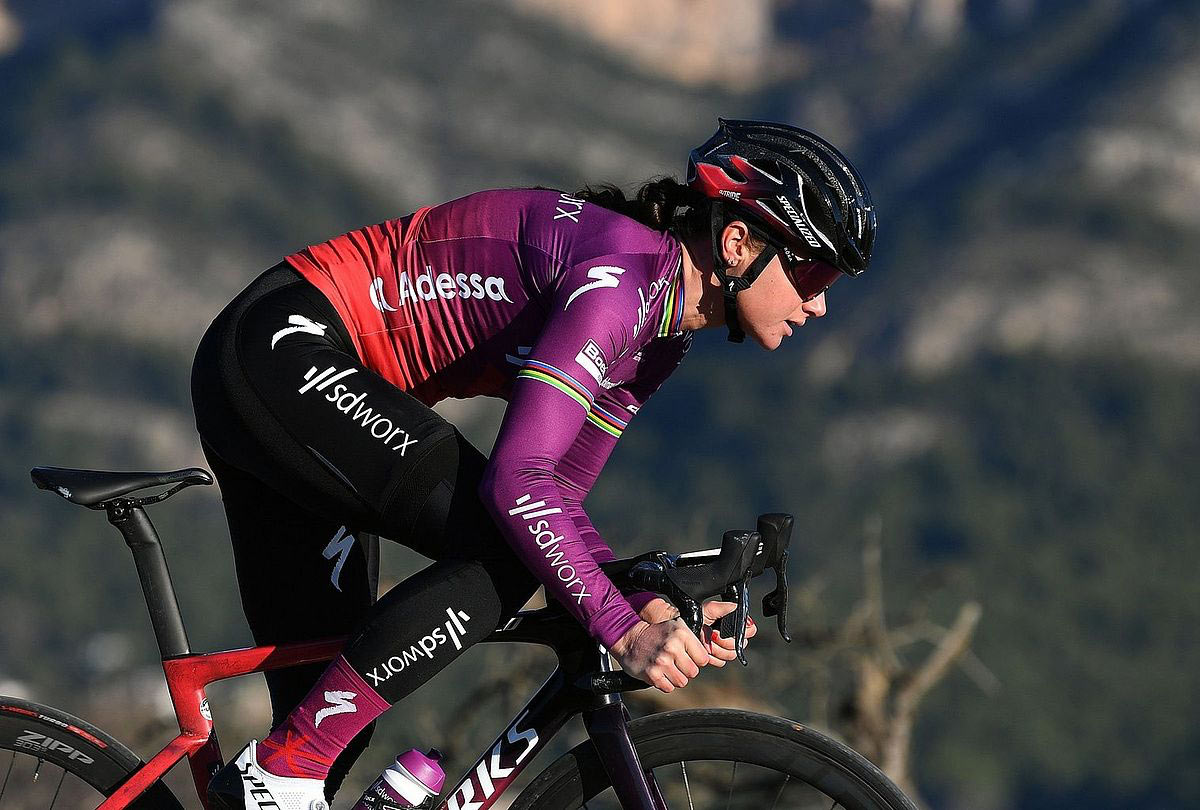
ROAD & GRAVEL BIKE HELMETS:
These are the most common-looking helmets, and what most people think of when they hear the words “bicycle helmet”. For a road rider, aerodynamics, weight, and ventilation are all primary considerations. A gravel rider usually rides a little slower on rural roads and wants to maximize ventilation, without as much focus on aerodynamics.
Road/Gravel helmets are mostly interchangeable and have the same features and design. They’re typically shallower in the rear and sides, have larger or more vents, and rarely come with a visor. Both scenarios benefit from hi-viz colors to improve the odds of drivers seeing you from a distance. The Specialized S-Works Prevail II shown on the rider above is a good example of a typical (albeit high-end) road bike helmet.
AERO HELMETS:
There are aero helmets, and then there are Aero Helmets. As in “aerodynamics”. The former are kinda sorta shaped like road helmets, but with fewer vents and, sometimes, an integrated sunglasses visor.
The Giro Vanquish (above, left) is a good example of this…there’s still some ventilation, but mostly it’s a smooth, uninterrupted surface to smooth airflow over your head. Think of this as your friendly neighborhood race helmet when saving seconds leads to free beers from friends.
Those alien-like helmets that you see on track racers and triathletes are Aero (with a capital A) helmets and have a tapered back that allows riders to be more streamlined. Most, like the Lazer Victor (above, right) come with built-in glasses, completely cover your ears, and have no or almost no vents. If you’re into triathlon, these are designed to maximize aerodynamics while you’re tucked into your aerobars.
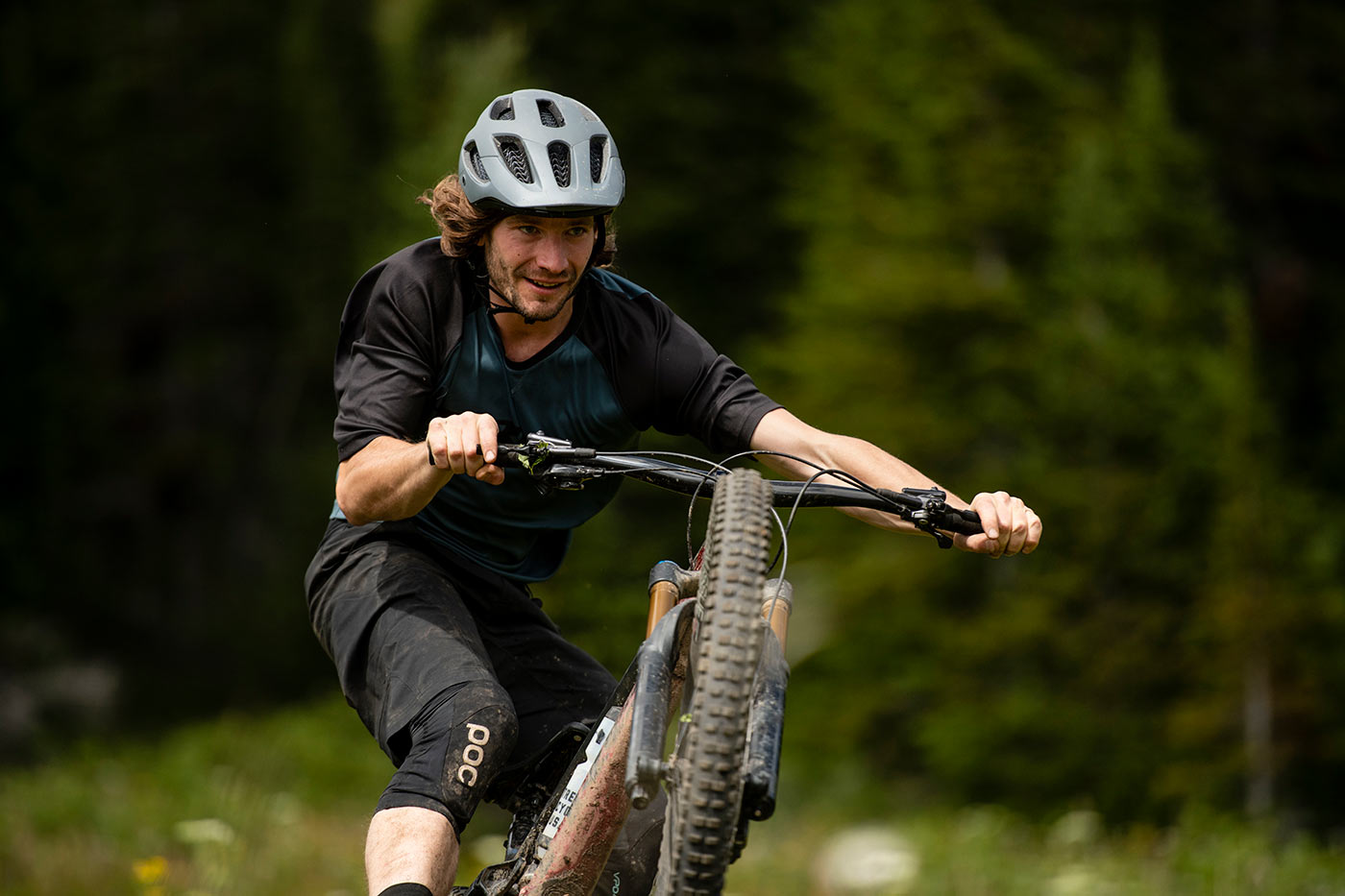
MOUNTAIN BIKE HELMETS:
There are a few styles of mountain biking helmets, but all should have deeper coverage and extended protection for the back of the skull and a visor. Helmets for more aggressive riding usually upgrade to an adjustable visor, and some add goggle integration.
However, long, slow, and/or technical climbs can build up a lot of body heat, too, so balancing ventilation with protection is a little harder here – bigger vents make it easier for rocks and sticks to poke through. Here’s how MTB helmets differ as you move up the scale of speed and risk:
Many top XC racers will end up using a lighter road helmet on race day, but for normal riding we recommend wearing a proper mountain bike helmet. The Kali Alchemy (above, left) is a great XC helmet because it has reasonable coverage that drops down further in the rear than a road helmet, plus a small, fixed visor.
The Troy Lee Designs A2 (above, right) is for Trail and All-Mountain riders, even enduro shredders that don’t need a full-face helmet. Notice how there’s deeper coverage in the rear and even a little more over the temples? And its visor is adjustable, letting you slide your goggles under it without having to fully remove them. Most helmets in this category have a groove or clip on the rear that helps keep a goggle strap in place, too.
Enduro, Downhill & Full-Face Helmets:
If you’re focused on the descents, like when racing enduro, or taking a lift or shuttle to the top, then you want a bigger helmet with more coverage. The Giro Tyrant (above, left) is the intermediate solution, with deep ear coverage to protect the side of your face, but keeping it lighter and more breezy than a full face helmet. If you’re climbing to the next downhill and don’t need a chin bar, go with something like this.
Next up the line are convertible full-face helmets like the MET Parachute (above, center). These have a removable chin bar that you can clip to your hydration pack for the climb up, then snap on before hitting the descent. When separated, the shell looks and feels more like a trail/all-mountain helmet, with bigger vents that make it fine for climbing. Combined, they offer similar face protection to what you’d get from a DH-level full face.
For true downhill and aggressive park riding, you’ll want a traditional one-piece full-face helmet like the Leatt Gravity 8.0 V21 (above, right). Notice that it has fewer vents, and they’re all covered by mesh panels. DH-level safety certifications require that the holes minimize intrusion from sticks and stuff, which is why you’ll find smaller and fewer vents on these.
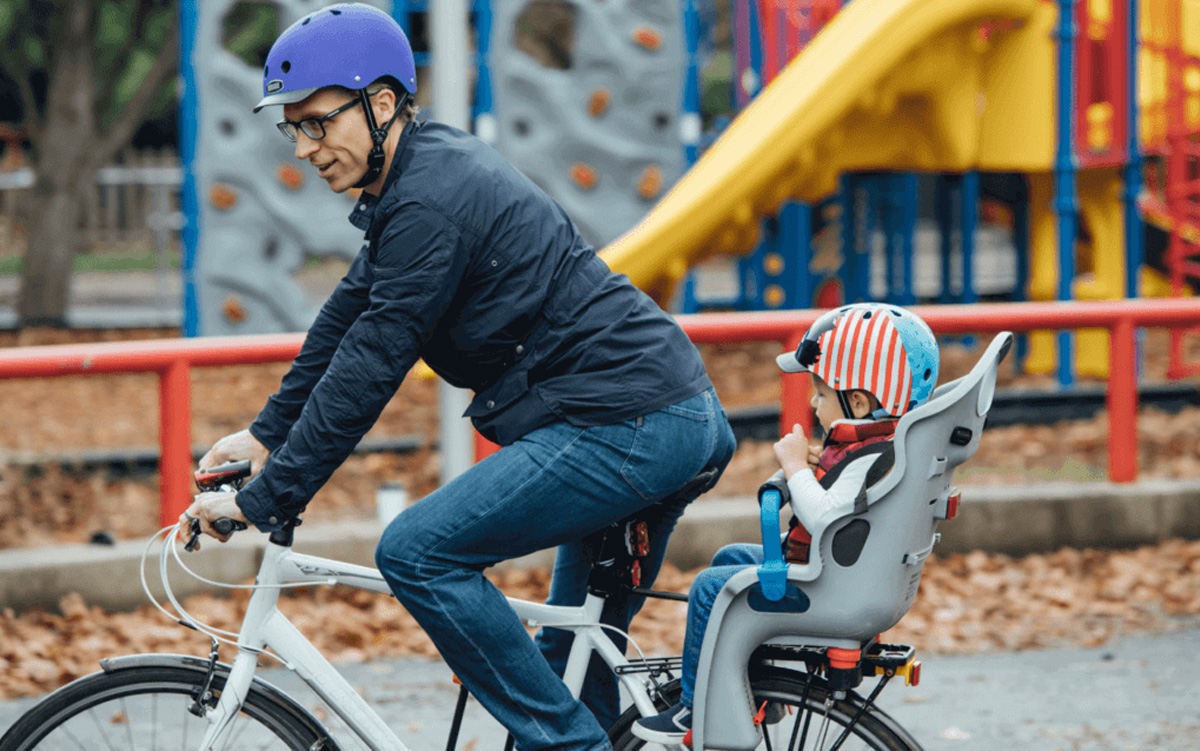
COMMUTER BIKE HELMETS:
When commuting, protection from the elements becomes more important. These helmets typically have fewer vents and broader padding, which can make them warmer (good for winter, not so much for summer), but also won’t give you “helmet hair”, which can look pretty funky on shorter hairstyles. They also tend to be less expensive, and most have a molded-in mini visor. Some models add mesh bug screens to the front vents, too.
Brands like Nutcase offer simple, affordable commuter and kids helmets in a ton of fun colors and styles. Brands with more comprehensive helmet offerings will have models with higher-tech features. The Giro Camden MIPS (above, left) and Abus Hyban 2.0 Signal (above, right) both incorporate rear blinky lights, and we love that Abus’ urban helmets actually have decent ventilation, too!
BMX/SKATE HELMETS: Similar to commuter helmets, these helmets have few vents and are most commonly worn by freestyle BMX riders. They offer little ventilation and are rarely equipped with safety features like MIPS, though some brands are starting to add additional features. Here, honestly, it’s as much about the aesthetic as the protection, which is why you won’t see BMXers rocking’ a “normal” bicycle helmet despite their better ventilation and lighter weight.
BMX FULL FACE HELMETS: For BMX racing on a track, riders will wear full-face helmets, similar to those worn by downhill mountain bikers.
How do I know what size helmet to buy?
Don’t equate your body size with head size: Plenty of small people wear large helmets and vice versa. Especially if you can’t try on a helmet before purchasing, measuring your head is critical.
Wrap a cloth tape measure around your head just above your ears, making sure that it’s parallel to the floor. Helmet sizes usually are listed in centimeters and will have a range (e.g., size small = 51-54cm). If you plan to ride in the winter with a cap under your helmet, or you wear a cycling cap or buff in the summer, make sure the helmet fits with the extra layer, but not too loosely without it. (You can even measure your head while wearing said cap or hat.)
If you’re upgrading or replacing a current favorite helmet and the new version adds MIPS, keep in mind that the extra protective layer adds material. If your current helmet fits snug, you may need the next size up when adding MIPS. Check the helmet size specifications on the website to make sure the measurements translate between models.
How should a helmet fit?
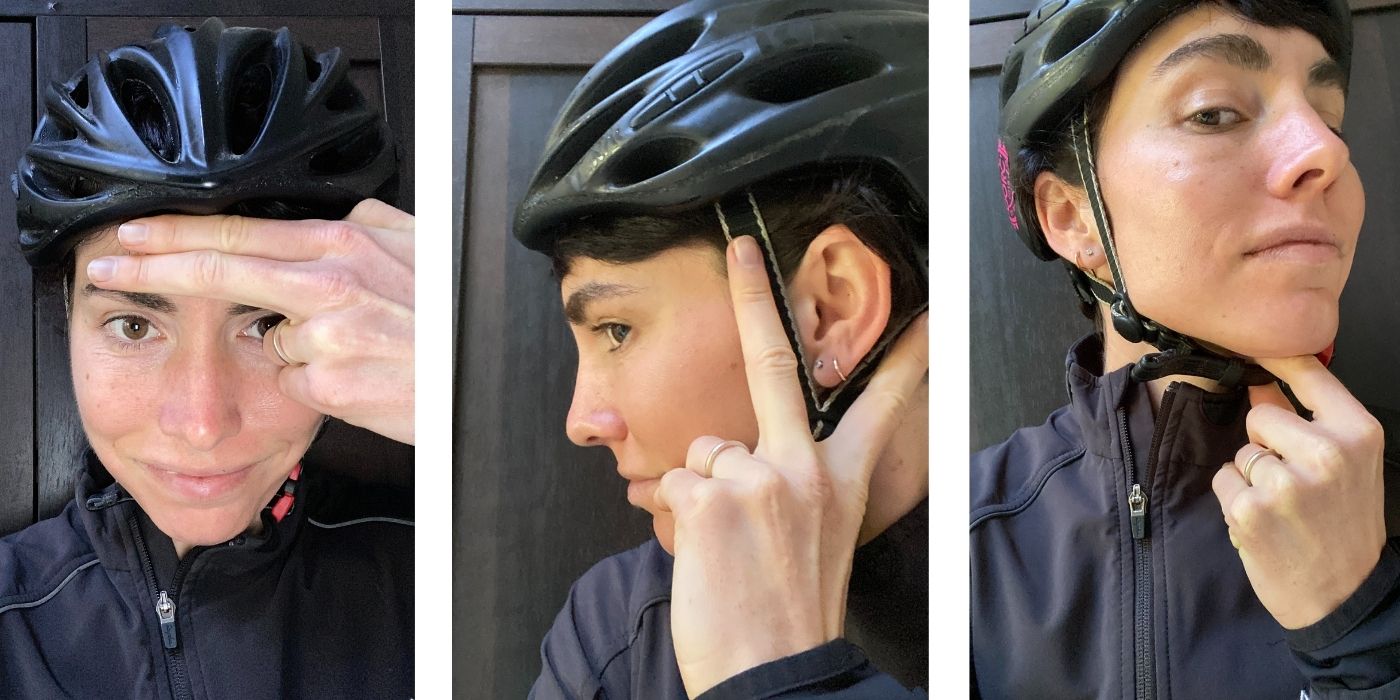
The “safest helmet” on the market won’t be very safe if it’s not correctly fitted to your head and positioned/tightened appropriately. Once you have the correct measurements and choose a helmet size, place it on your head to double-check.
The easiest way to fit a helmet is with the 2V1 acronym. You should be able to fit two fingers between your eyebrows and the top of the helmet, make a V-shape with your index and middle fingers around your ears to feel where the straps should sit, and be able to fit one finger under the strap at your chin.
The primary spot you’ll adjust your helmet is the strap, but remember that in addition to strap length, you can also adjust where the bottom of the triangle sits (on some helmets). The closer you can bring the bottom of the triangle to the bottom of your ear, the better. Most helmets will also have a dial in the back to tighten an internal retention system that allows for an even closer fit.
You should be able to shake your head up and down vigorously without the helmet falling off or wobbling around even when the helmet is unclipped—that indicates it’s fitted properly to your head.
Don’t wear it back on your head like a hat…this leaves your entire forehead exposed to impact!
Try to push the helmet off the back of your head. If you can move it substantially, to a point where all of your forehead or more is exposed, readjust the straps… or find a different helmet. Every brand fits a little differently, not every helmet will fit every head. What works great for your riding buddies (or your favorite pro) may not work for you. A great way to figure out what helmet you want is by trying friends’ helmets on before a ride to see how different models fit and feel.
For riders with long hair, securing it either low and under the helmet or between the helmet and the dial is ideal. Some helmets have more separation between the helmet and dial in order to allow for buns and ponytails to fit. For riders with bigger, curly hair or Afros, the best solution is to use a Buff or cap to keep hair tighter to the head in order to make sure the helmet is as close-fitting as possible.
What makes a helmet safe?
In the US, helmets are required to be CPSC-certified, which shows that a helmet can provide protection against “catastrophic injuries in extremely severe impacts.” In Europe, this testing is referred to as CE.
While that’s a great starting point, a helmet that offers protection in less catastrophic situations (like a slow-speed crash) is important. Many brands say the CPSC testing requires a helmet that’s too hard, and that softer foams and materials would actually be safer in the vast majority of real-world accidents because they’d be better able to absorb the more common low speed impacts. In recent years, anti-rotational technologies inside of helmets have been used to improve safety in those lower speed impacts.

Testing that goes beyond the CPSC’s standards happens through Virginia Tech’s rating system. Done in collaboration with the Insurance Institute for Highway Safety, the team at Virginia Tech tests more than 100 helmets each year and gives each a ranking and a safety score. Here’s a list of the safest helmets of 2021.
However, Virginia Tech also notes that a helmet is only safe when worn properly. A loose helmet won’t provide the same level of protection when hitting an anvil!
What are some of the added safety features used in helmets?
The primary safety features in adult bike helmets fall into two categories: Impact protection, and Rotational Impact protection. The goal for both is to minimize how much impact reaches your brain, because anytime your brain moves inside your skull, that’s not a good thing.

IMPACT PROTECTION:
This is the original reason helmets were created. The EPS styrofoam is used to absorb impact forces from a crash. Some helmets layer different foam densities to better handle different impact speeds. Softer foams work better at low-speed impacts, which is often what’s experienced in a bicycle accident. But current testing standards basically require that helmets have a harder foam in order to pass, even though these firmer foams are harder to crush and therefore transmit more forces to your head in a crash.

Some helmet companies replace some of the foam with shaped plastic tubes (Koroyd, above) or wavy structures (WaveCel, below), but the idea is the same – those structures crush, bend, and deform to absorb impact. These alternatives unfortunately tend to reduce airflow as they typically fill in the vented channels, and sometimes end up adding more weight than the EPS they replace (sad trombone), so we have mixed feelings on them.

The other aspect of impact protection is how well a helmet will stay together during said impact. If the foam shatters and cracks apart at the first hit, that leaves big gaps for the pavement, rocks, or logs to smash through and hit you directly.
The shiny, colorful polycarbonate shell on the outside of your helmet is the first line of defense against breakage. On every good helmet, it’s co-molded – the EPS and the shell are molded into one piece and can’t come apart. This provides an exoskeleton to hold your helmet together during impact.

Higher-end helmets rely on internal structures, too. With bigger vents for better air flow, there’s less shell to hold it together. The good brands will add an internal frame or skeleton that’s co-molded inside the EPS to hold it all together in a crash. You can see some of that framework protruding on helmets like the Specialized Prevail II Vent (above). This makes a helmet pricier, but you get a lighter, more breathable helmet that’s more enjoyable to wear—and still safe.
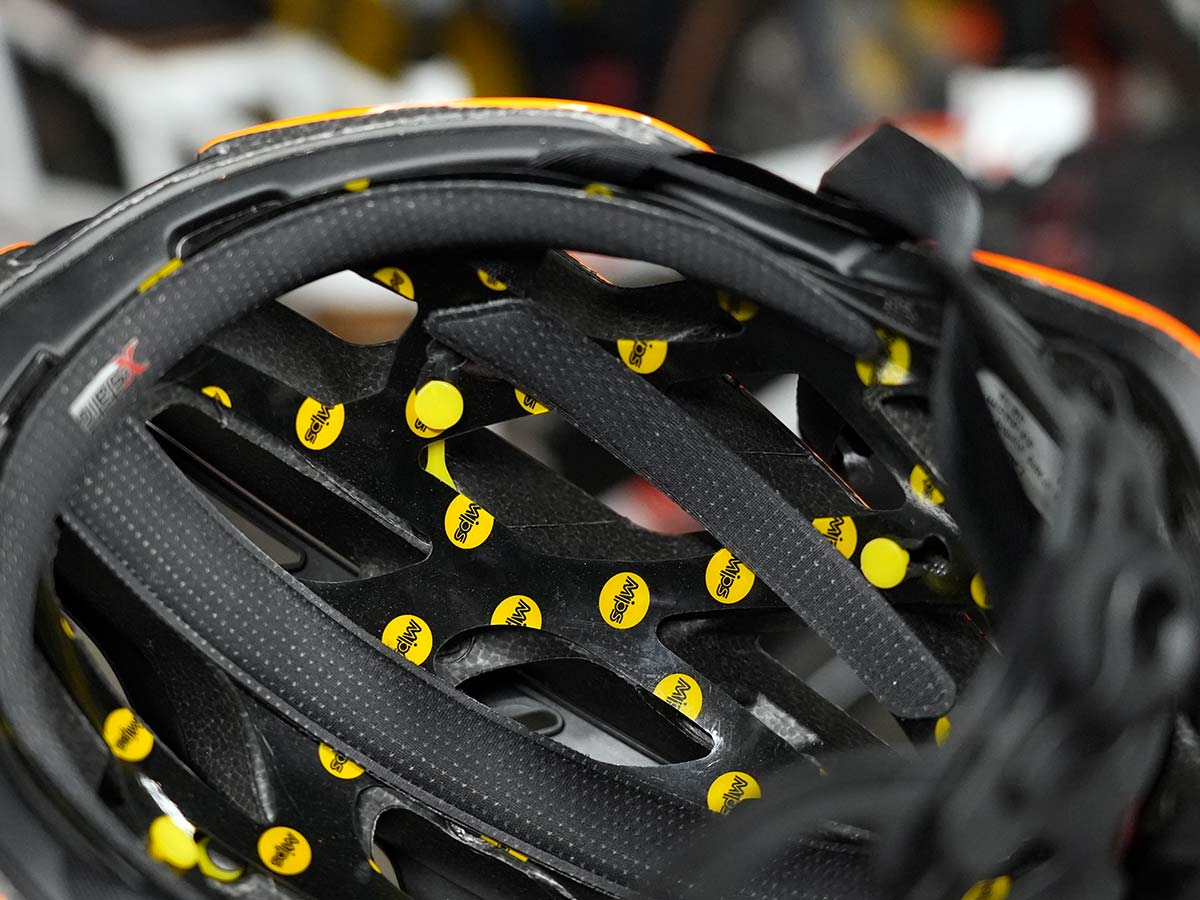
ROTATIONAL IMPACT PROTECTION:
The other big buzzword in bicycle helmet safety in recent years is Rotational Impact protection. Rotational impact comes into play any time your head is hitting something at a non-right (not 90º) angle, which can cause your head to turn or be pulled in a non-linear direction in addition to whatever impact forces it just experienced. Meaning, if you’re not hitting something exactly straight on at a 90º angle – which would rarely happen – then you’ll have some rotational forces impacting your head.
The most common anti-rotation tech is the Multi-directional Impact Protection System (MIPS). It is a secondary layer between your scalp and the helmet, installed such that the outer shell of the helmet can slip, tilt, and rotate several degrees before that rotation reaches your head.
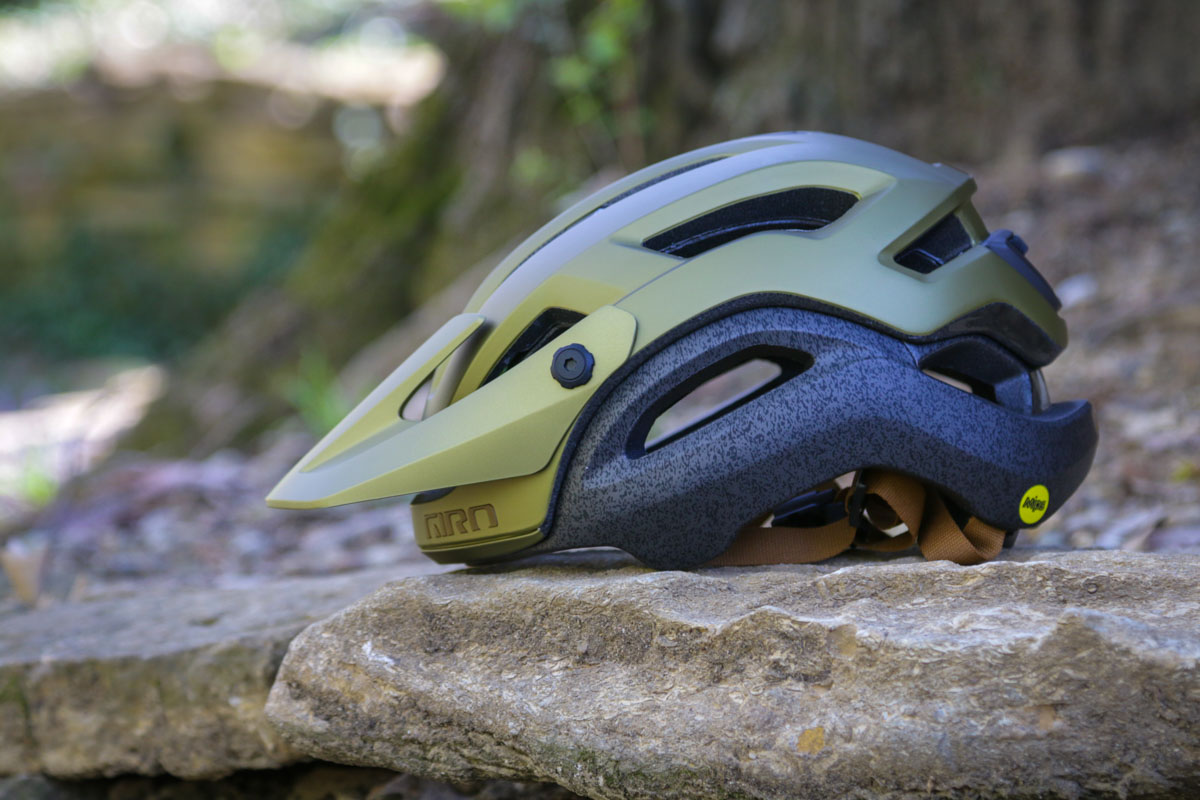
So, as the helmet hits the ground in a crash, it’s theoretically absorbing more rotational forces than a helmet without MIPS, thus reducing concussion risk. Just like there’s 1-1.5cm of EPS foam that can crush, there’s anywhere from 1-1.5cm (on average) of additional rotation provided by MIPS before your head is going to start moving in a different direction, too.
Fortunately, in either case, that small amount of “cushion” is enough to dramatically reduce the forces that reach your brain.
Some brands have competing designs rather than license MIPS’ technology and branding, but the concept is the same – reduce rotational forces. Leatt’s Turbine 360 (above) and Kali’s LDL (below) are some of our favorites because they also add a bit of softer cushioning, but anything that allows the helmet to twist or tilt independently of your head falls into that category.
It’s worth noting that your hair and scalp also provide some of these same benefits. And any of these anti-rotation add-ons will increase the cost and weight of a helmet.
Fortunately, the cost of adding MIPS and other anti-rotation techs has fallen dramatically. And any extra bit of protection you can add to a helmet is a good thing, especially when there are few if any downsides. But we share all of this because it’s important to understand that any of the helmets we recommend or list here are great helmets even if you opt for a version without MIPS.
Are MIPS helmets better than non-MIPS bicycle helmets?
Every helmet that tops the Virginia Tech rankings has MIPS technology—but that does NOT automatically mean they are better. The testing Virginia Tech does is similar to how MIPS tests their helmet standards, so it makes sense that MIPS helmets would do well in this specific situation. Also, most of the brands that sent helmets in chose to send their MIPS-equipped models, so there’s a selection bias.
Most brands want to sell you their MIPS versions because they are more expensive and have a perceived benefit, so these are the models they send in for testing. So, it’s not a random selection of all helmets on the market, with or without MIPS and MIPS-like features.
These tests also do not account for hair and skin movement, and there’s no neck movement to twist or bend, which would further mitigate direct rotational forces on the head.
The takeaway? MIPS is probably a good thing, but don’t think that just because non-MIPS helmets aren’t ranked as highly on this list that they aren’t just as safe.
Frequently Asked Questions
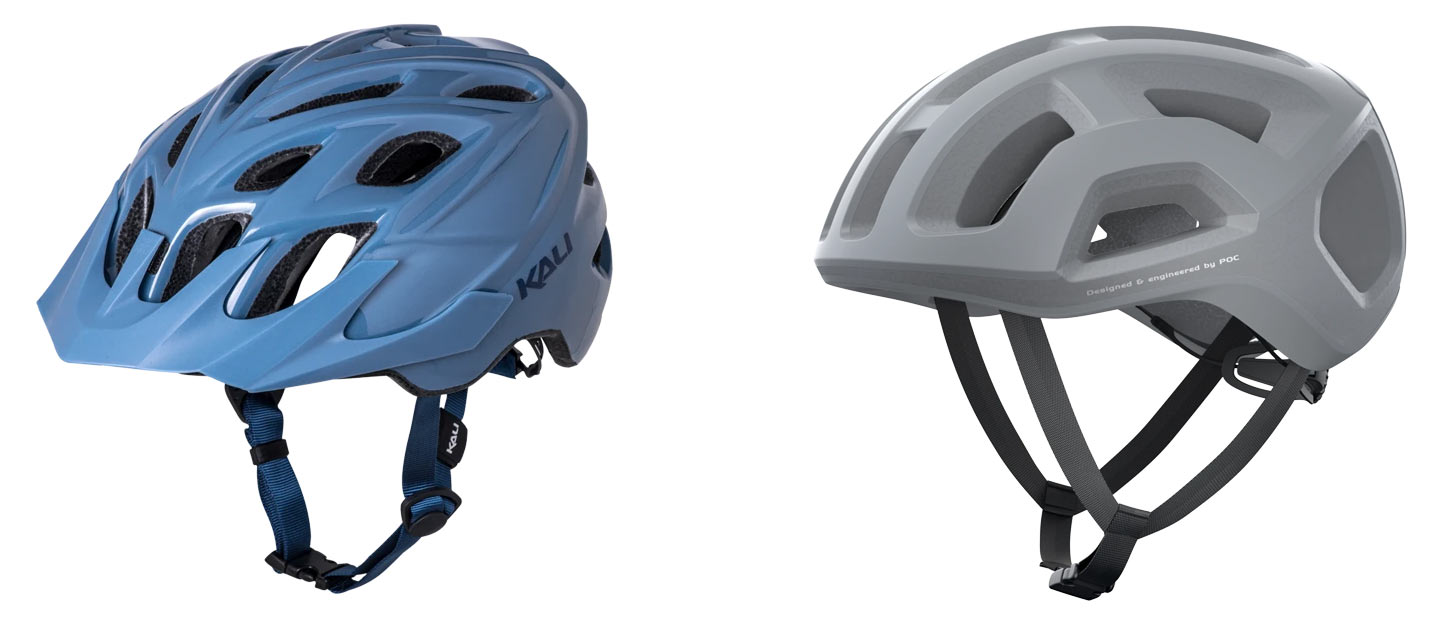
How much should a helmet cost?
The TL;DR answer is this: As much as you want it to. Good helmets start around $50 and go up to $300 or more. It depends on which bells and whistles you’re looking for.
There are great helmets with top safety rankings like the Specialized Align II that are only $50, while other helmets can easily cost ten times more. Bigger helmets are also usually more expensive, so expect to spend more for a full-face downhill helmet versus a commuter lid.
And, the lighter a helmet is, the pricier it will be. That’s because it takes a lot more engineering and expensive materials (like carbon fiber) to reduce weight without compromising safety.
And while we don’t recommend any big-box or off-brand helmets, it’s important to remind you that any helmet is better than no helmet. Anything sold in a legitimate retailer must pass the same safety standards. If your price range is sub-$25, you should still buy a helmet, even if it doesn’t have the latest and greatest technologies.

Why would I want a visor on my helmet?
Many mountain bike helmets come with detachable visors. These help block branches and other trail debris on rides. For mountain bike helmets, look for models that have removable or adjustable visors that can break away during a wreck.
Some road and gravel helmets are also adding optional visors to help block the sun and keep some rain off of your glasses. We love Bontrager’s NeoVisor for this: The mini-visor looks like you’re wearing a classic cycling cap under your cap, but doesn’t block the vents or add bulk under the helmet like a cap would. And, we’ve been able to fit it into other brands’ helmets, too, making it a great little add on.
Many commuter helmets have either a small lip of a visor built into the shape, or a small detachable one included, but these are usually too small to block the sun or the rain.
What should I look for when it comes to padding?
Padding inside a helmet serves two purposes, neither of which is safety related. Most importantly, it provides comfort and prevents rubbing between the helmet and your head. Critical if you don’t have a lot of hair!
It also absorbs sweat and helps to keep it from dripping into your eyes, though heavy sweaters may want to add a Buff or headband to absorb some of the liquid. When helmet shopping, look for padding with antimicrobial properties which reduce odor. Also, padding that can be removed and washed either by hand or in the gentle cycle is a valuable feature. Removable padding also lets you replace it when worn out.
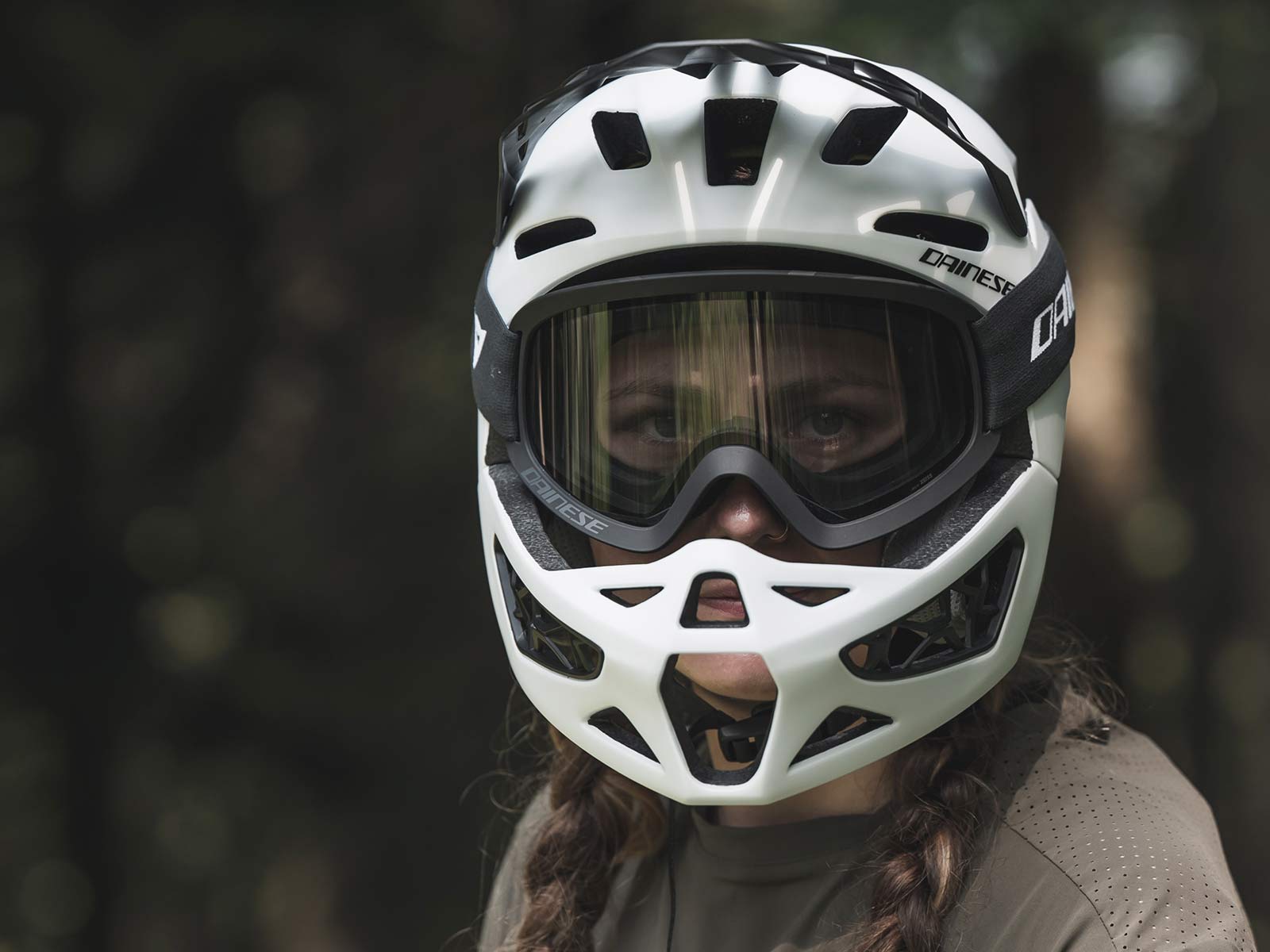
Why would I wear goggles instead of sunglasses?
You’ll mostly find goggles on downhill or enduro mountain bikers, but goggles are great for harsh winter commutes and fat biking as well. Like ski goggles, they offer more protection than sunglasses. If you’re wearing a full-face helmet, they’ll fit -and look- a lot better than sunglasses, too.
Most full-face, convertible, or enduro-style mountain bike helmets are shaped to accommodate goggles. Many even have clips or channels on the rear to keep the strap from sliding out of place. Other types of helmets, like those for road, gravel, and XC MTB, are not shaped in a way that works with goggles. If you plan to wear goggles, bring them with you when shopping for a helmet to make sure they fit well with that specific helmet.
If you’re helmet shopping in a store and you love your current riding sunglasses, we also recommend bringing those with you. Different helmets have different fits that accommodate different styles of sunglasses better than others. They also may have channels that allow you to stick the sunglasses into the helmet when you don’t need them, but again, some glasses will fit certain channels better than others.
Why is a name-brand helmet so much cheaper online than in my local bike shop?
Buyer beware; counterfeit bike helmets are all over the internet. If the price is too good to be true, it’s probably a fake. And yes, this matters: A counterfeit helmet is not manufactured to the same safety specifications as a non-counterfeit helmet. Don’t take that chance. If you buy online, stick to a reputable dealer.
We also recommend shopping for a helmet at your local bike shop. It’s nice to have the ability to try it on, and they’ll help find the best model for your head shape.
But the answer to your question is this: Many brands sell unsold inventory to online stores in bulk, at a big discount, when they need to make room for new models. So, if you don’t mind last year’s colors or designs, and you already know how it will fit (or that it will fit correctly), then there are deals to be had.
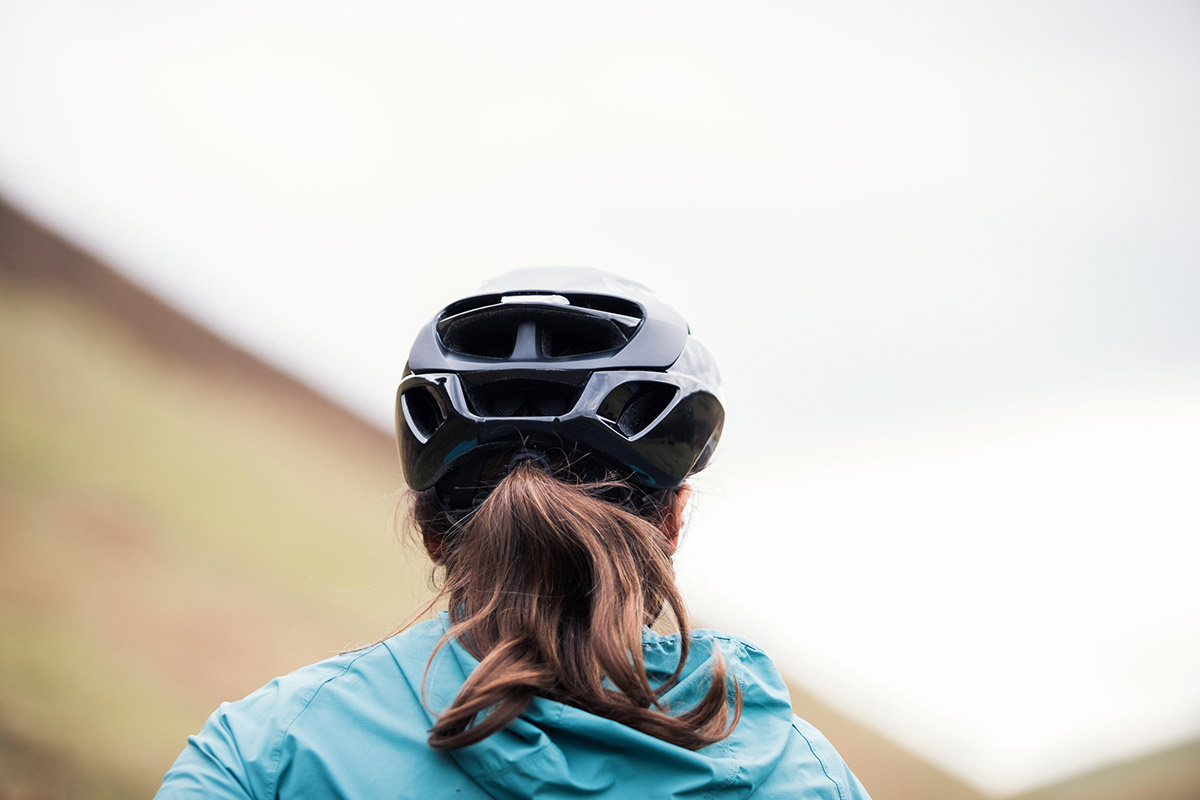
Do I need a women’s specific helmet?
There’s really no such thing as a “women’s specific” helmet, so don’t expect to find one in any bike shop. But for those with longer hair, a helmet with a wider opening in the back, between the bottom of the shell and the tension adjustment strap or dial is ideal. This feature allows you to pull your hair through that spot without interfering with the tension system. Check out our Women’s Helmet Buyer’s Guide for more tips on finding a great helmet.
When should I replace a bike helmet?
After any crash where you sustained a hit to the helmet, you should absolutely replace it. Many companies will even offer crash replacement helmets for free or at a discount, especially within the first year after purchasing, so check with your helmet manufacturer post-crash.
Side note: If your helmet is damaged in a crash and you’re using any type of insurance or pursuing any legal action, save that damaged helmet. Cycling lawyer Ian Brisbin recommends hanging onto any torn kit or damaged goods post-crash, in case you need it later as evidence.
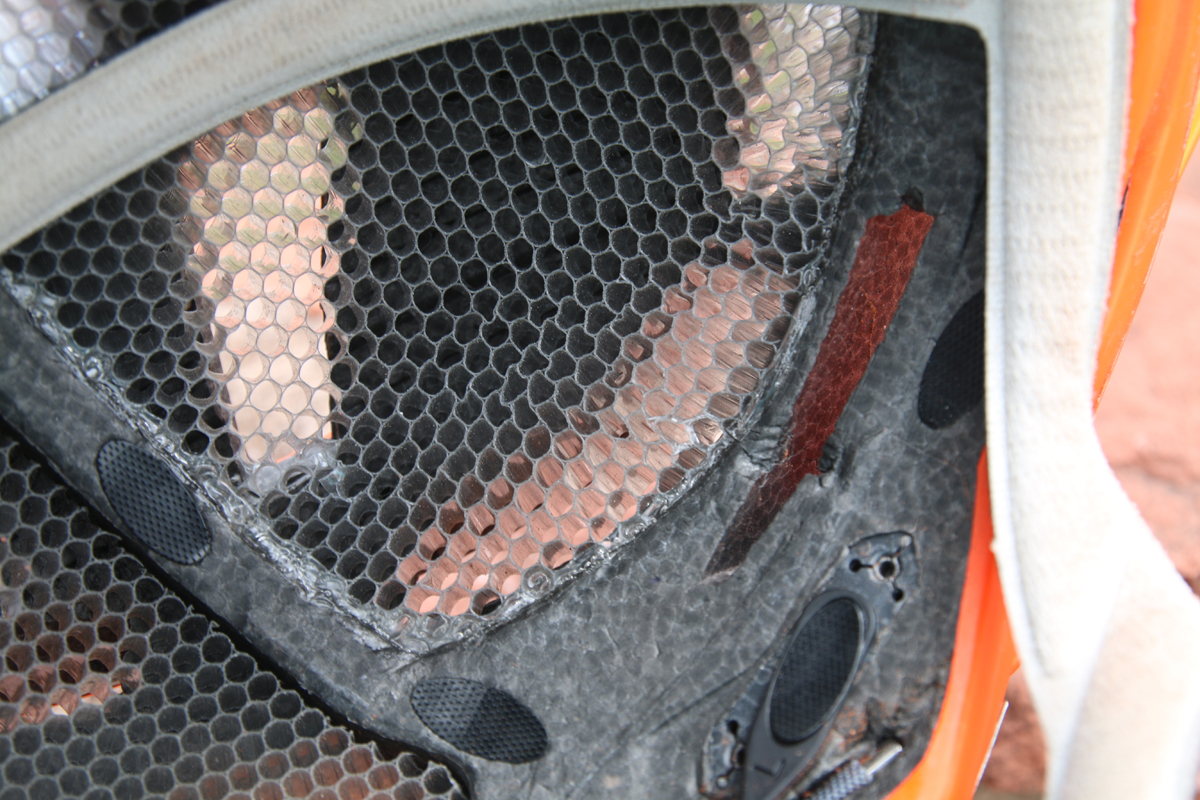
Check your helmet regularly for cracks or breaks, since occasionally, helmets can hit the ground and get cracked. Kids play in the garage? All it takes is one shove and your pricey helmet is cracked after hitting concrete during a game of tag.
The good news is that if you haven’t crashed, your helmet should last for quite a while. Consumer Reports notes that unless there’s a compelling reason – like a crash or a broken strap – to replace your helmet, you can keep it as long as you want. Don’t try to dabble in helmet repair. If a strap breaks, contact the company rather than busting out super glue.
That said, technology is improving rapidly. If you’re still using your foam helmet from the early 90s, you may want to replace it simply because the tech has come such a long way in the last two decades. The foam on your 1992 neon pink helmet might still be intact (and the color is now retro-chic), but that helmet won’t have MIPS or a BOA-style fit system.
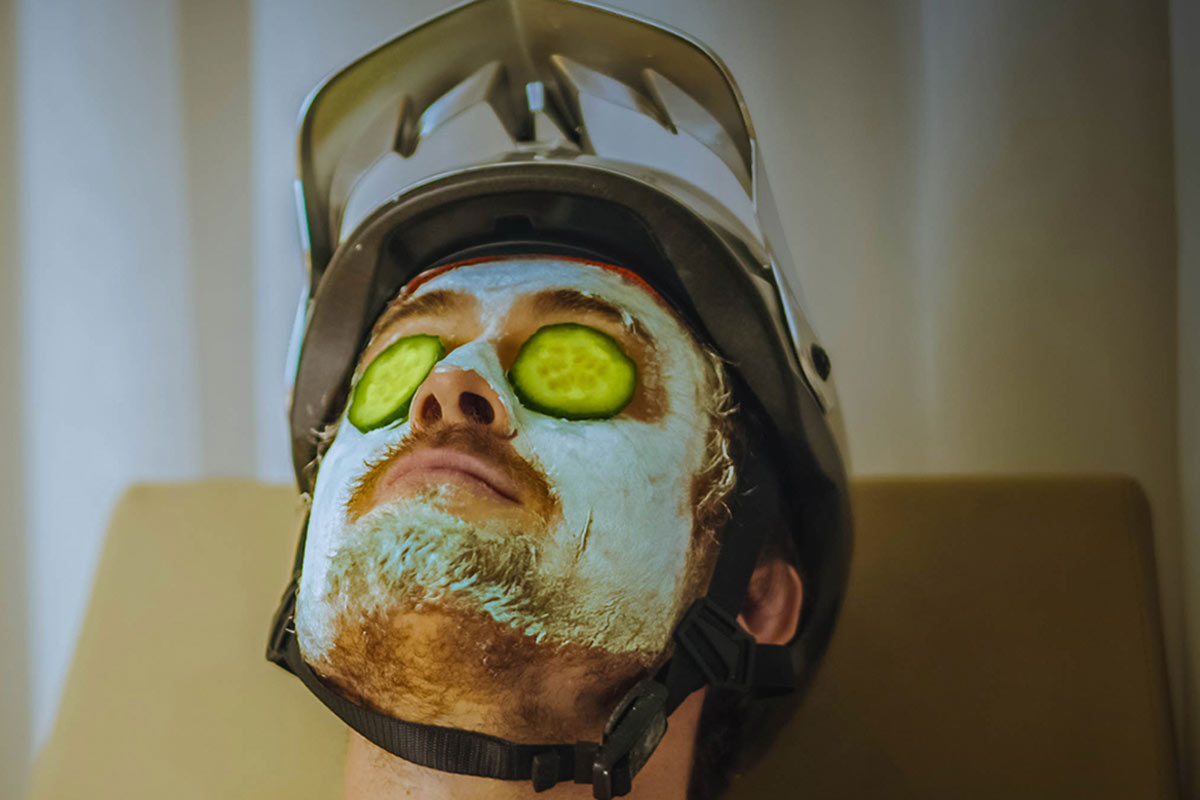
How can I take care of my helmet?
Store your helmet at home carefully: If it’s balanced on a top shelf in the garage and gets knocked over, that could be the end of your helmet’s lifespan. And store your helmet out of the sun and heat…Don’t leave them in your car or laying out in the backyard. The sun may bleach some of the color from your high-vis helmet over time…and degrade the EPS foam.
Clean your helmet regularly as well. This means wiping down the hard bits of your helmet, but it also means carefully cleaning your helmet pads and straps. We like padding that can be removed and hand-washed or tossed in the laundry, and you should be doing this regularly, especially if you’re prone to breakouts.
You should also give your helmet strap a good wash regularly, using dish soap to cut grease from oily skin, sunscreen, and the sports drink that dribbled down your chin on your last ride. Helmet straps can get extremely gross, and can lead to serious chin breakouts for acne-prone skin if not treated with care.
How can I take care of my helmet while traveling?
Helmets should stay with you on a plane, preferably in your carry-on. Remember that helmets aren’t made to withstand compression, especially side compression since your head is normally there to provide something to press against.
If your helmet is crammed in a soft bike bag, and then the bag is tossed in a pile in the belly of a plane, that helmet could be compressed for hours. This editor had her own compress-and-snap issue when traveling with a pricey helmet in her bike bag years ago. The same is true packing a trunk of a car: make sure your helmet isn’t squished!
Am I required by law to wear a helmet when biking?
While there is no federal law in the U.S. requiring an adult to wear a helmet, some state, and local laws cover children, adults, and eBikes. They vary by region, so check the laws in your state to see what’s required…or just wear one anyway because you only have one brain!
How do I know what helmet to choose?
We have a few ideas! Check out these posts for our top picks:
Got a question about bicycle helmets? Leave it in the comments and we’ll do our best to answer it!
